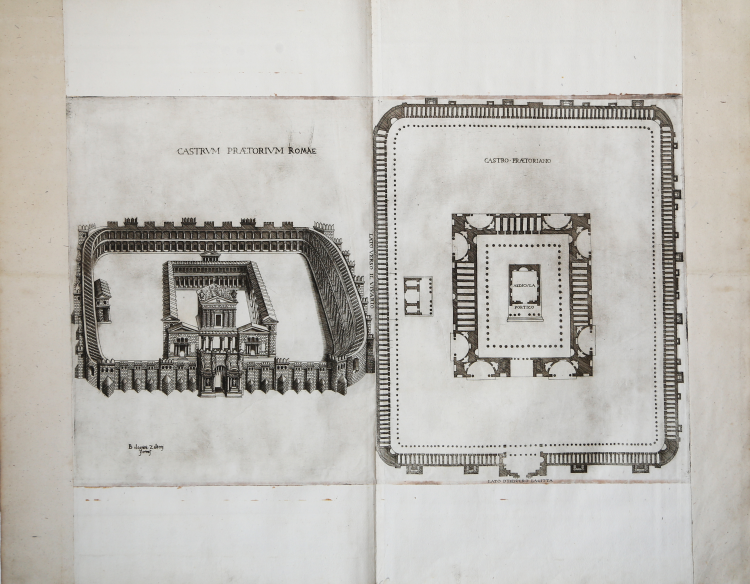




| Reference: | S45026 |
| Author | Bolognino ZALTIERI |
| Year: | 1565 ca. |
| Zone: | Castro Pretorio |
| Measures: | 520 x 325 mm |



| Reference: | S45026 |
| Author | Bolognino ZALTIERI |
| Year: | 1565 ca. |
| Zone: | Castro Pretorio |
| Measures: | 520 x 325 mm |
Engraving, c. 1565/70, signed lower left: Bolognini Zalterij Formis. After a subject by Pirro Ligorio.
Inscribed at upper right: CASTRVM PREATORIVM. Upper left CASTRO PRAETORIANO.
Example in the first state of two for Huelsen and Rubach, who describe a reprint with date 1597 by Donato Rascicotti.
This is the very rare Venetian replica - copied in counterpart - of the reconstruction of the Castra Praetoria, engraved by Bolognino Zaltieri on the model by Pirro Ligorio, published in Rome by Michele Tramezzini in 1553.
Zaltieri's work was probably done when the ten-year privilege of both the Serenissima and the Papal States, granted to Michele Tramezzini, expired. This very rare work is only described by Huelsen.
Magnificent proof, richly toned imprinted on contemporary laid paper with "pilgrim in the circle" watermark (see Woodward nos. 4-7), trimmed to copperplate and with contemporary margins added, in excellent condition.
“It was Pirro Ligorio from the findings excavated in 1553 who first noticed that the enclosure was the Castrum Praetorium, the barracks of Emperor Tiberius. The Praetorians had been established by Augustus as the emperor's permanent guard. Tiberius concentrated the troops in a single stable encampment, building precisely the Castra Praetoria between 21 and 23 CE in the northeastern part of the city. The engraving was first proposed by Francesco and Michele Tramezzino (1553), later by Bolognini Zalterij active in Venice from 1558 to 1570, and, finally, by Claude Duchet, engraved by Ambrogio Brambilla (1581)” (translation from C. Marigliani, Lo splendore di Roma nell’Arte incisoria del Cinquecento).
The work belongs to the Speculum Romanae Magnificentiae, the earliest iconography of ancient Rome.
The Speculum originated in the publishing activities of Antonio Salamanca and Antonio Lafreri (Lafrery). During their Roman publishing careers, the two editors-who worked together between 1553 and 1563-started the production of prints of architecture, statuary, and city views related to ancient and modern Rome. The prints could be purchased individually by tourists and collectors, but they were also purchased in larger groups that were often bound together in an album. In 1573, Lafreri commissioned a frontispiece for this purpose, where the title Speculum Romanae Magnificentiae appears for the first time. Upon Lafreri's death, two-thirds of the existing copperplates went to the Duchetti family (Claudio and Stefano), while another third was distributed among several publishers. Claudio Duchetti continued the publishing activity, implementing the Speculum plates with copies of those "lost" in the hereditary division, which he had engraved by the Milanese Amborgio Brambilla. Upon Claudio's death (1585) the plates were sold - after a brief period of publication by the heirs, particularly in the figure of Giacomo Gherardi - to Giovanni Orlandi, who in 1614 sold his printing house to the Flemish publisher Hendrick van Schoel. Stefano Duchetti, on the other hand, sold his own plates to the publisher Paolo Graziani, who partnered with Pietro de Nobili; the stock flowed into the De Rossi typography passing through the hands of publishers such as Marcello Clodio, Claudio Arbotti and Giovan Battista de Cavalleris. The remaining third of plates in the Lafreri division was divided and split among different publishers, some of them French: curious to see how some plates were reprinted in Paris by Francois Jollain in the mid-17th century. Different way had some plates printed by Antonio Salamanca in his early period; through his son Francesco, they goes to Nicolas van Aelst's. Other editors who contributed to the Speculum were the brothers Michele and Francesco Tramezzino (authors of numerous plates that flowed in part to the Lafreri printing house), Tommaso Barlacchi, and Mario Cartaro, who was the executor of Lafreri's will, and printed some derivative plates. All the best engravers of the time - such as Nicola Beatrizet (Beatricetto), Enea Vico, Etienne Duperac, Ambrogio Brambilla, and others - were called to Rome and employed for the intaglio of the works.
All these publishers-engravers and merchants-the proliferation of intaglio workshops and artisans helped to create the myth of the Speculum Romanae Magnificentiae, the oldest and most important iconography of Rome. The first scholar to attempt to systematically analyze the print production of 16th-century Roman printers was Christian Hülsen, with his Das Speculum Romanae Magnificentiae des Antonio Lafreri of 1921. In more recent times, very important have been the studies of Peter Parshall (2006) Alessia Alberti (2010), Birte Rubach and Clemente Marigliani (2016).
Bibliografia
C. Hülsen, Das Speculum Romanae Magnificentiae des Antonio Lafreri (1921), n. 35/A; cfr. Peter Parshall, Antonio Lafreri's 'Speculum Romanae Magnificentiae, in “Print Quarterly”, 1 (2006); cfr. B. Rubach, Ant. Lafreri Formis Romae (2016), n. 296, I/II; cfr. A. Alberti, L’indice di Antonio Lafrery (2010), n. A 120, II/IV; cfr. Marigliani, Lo splendore di Roma nell’Arte incisoria del Cinquecento (2016), n. II.18; cfr, D. Woodward, Catalogue of watermarks in Italian printed maps 1540 – 1600 (1996).
Bolognino ZALTIERI(Attivo a Venezia nel 1566)
Bolognino ZALTIERI(Attivo a Venezia nel 1566)